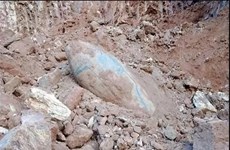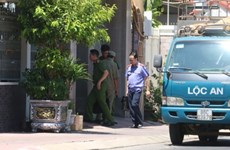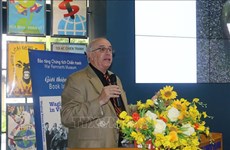Farmers near park rise from poverty
A programme to develop farming in the
buffer zone of a national park in southern Kien Giang province has
lifted more than 50 percent of its residents out of poverty, an official
said.
A programme to develop farming in the
buffer zone of a national park in southern Kien Giang province has
lifted more than 50 percent of its residents out of poverty, an official
said.
Truong Quoc Tuan, secretary of the province Party Committee, said the poverty rate in the U Minh Thuong National Park buffer zone had fallen to 18 percent compared to 70 percent in 1999 when the project began.
In 1992 the Mekong Delta province established the 14,290-hectare buffer zone in An Minh district's An Minh Bac commune and Vinh Thuan district's Minh Thuan commune.
Kien Giang authorities moved more than 3,500 families without farmlands into the area.
In 1999 they unveiled a 181 billion VND (9.5 million USD) programme to develop agriculture by giving each household four hectares of land and a loan of 25-30 million VND.
The families had to grow cajeput on 1ha and farm fish or grow sugarcane, pineapple, vegetables, and fruits on the remaining area.
By the end of last year the average annual income of the households had risen to 51.1 million VND (2,700 USD), according to the Buffer Zone Steering Committee.
According to Nguyen Hoang Nam , an official in the An Minh Bac Commune People's Committee, many families earn more than 100 million VND.
Nguyen Minh The, 58, of An Hoa hamlet in An Minh Bac, said his family moved to the area in 1993 and earned a living by catching fish and picking water morning glory.
It had since benefited from the project and now earned around 50 million VND a year, he said.
When he moved in, the area had been desolate and covered in weeds but now there were asphalt roads and electricity, he said.
Secretary Tuan admitted that the average income in the buffer zone remained lower than the province average.
But the province would continue to invest in its infrastructure to build and upgrade roads, bridges, schools, and clinics, he promised. It was also building the U Minh Thuong Cultural and Historical Heritage Area to develop tourism to improve people's income.
The U Minh Thuong National Park receives an average of 2,000 local and foreign tourists a month.
The 148,758ha national park is the last remaining peat wetland in Vietnam and belongs to the UNESCO-recognised Kien Giang Biosphere Reserve./.
Truong Quoc Tuan, secretary of the province Party Committee, said the poverty rate in the U Minh Thuong National Park buffer zone had fallen to 18 percent compared to 70 percent in 1999 when the project began.
In 1992 the Mekong Delta province established the 14,290-hectare buffer zone in An Minh district's An Minh Bac commune and Vinh Thuan district's Minh Thuan commune.
Kien Giang authorities moved more than 3,500 families without farmlands into the area.
In 1999 they unveiled a 181 billion VND (9.5 million USD) programme to develop agriculture by giving each household four hectares of land and a loan of 25-30 million VND.
The families had to grow cajeput on 1ha and farm fish or grow sugarcane, pineapple, vegetables, and fruits on the remaining area.
By the end of last year the average annual income of the households had risen to 51.1 million VND (2,700 USD), according to the Buffer Zone Steering Committee.
According to Nguyen Hoang Nam , an official in the An Minh Bac Commune People's Committee, many families earn more than 100 million VND.
Nguyen Minh The, 58, of An Hoa hamlet in An Minh Bac, said his family moved to the area in 1993 and earned a living by catching fish and picking water morning glory.
It had since benefited from the project and now earned around 50 million VND a year, he said.
When he moved in, the area had been desolate and covered in weeds but now there were asphalt roads and electricity, he said.
Secretary Tuan admitted that the average income in the buffer zone remained lower than the province average.
But the province would continue to invest in its infrastructure to build and upgrade roads, bridges, schools, and clinics, he promised. It was also building the U Minh Thuong Cultural and Historical Heritage Area to develop tourism to improve people's income.
The U Minh Thuong National Park receives an average of 2,000 local and foreign tourists a month.
The 148,758ha national park is the last remaining peat wetland in Vietnam and belongs to the UNESCO-recognised Kien Giang Biosphere Reserve./.













